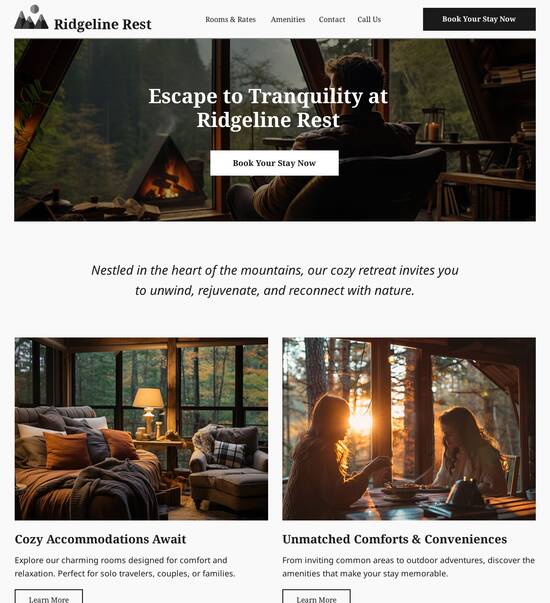
Basic order history page template
Explore Similar TemplatesAbout template
Unleash your creativity with the basic order history page template. Try Instapage today.
Recommended templates

Easy to build without coding
With the intuitive drag-and-drop builder, anyone on your team can create high-converting pages without any knowledge of code or design. Make enhancements to your landing page with custom widgets using Javascript, HTML/CSS, or third-party scripts.

Multiple layouts for any industry and goal
Select from 500+ landing page layouts built to boost conversions across industry-specific scenarios. Customize them by adjusting fonts, adding images, and generating on-brand content with the AI assistant. Quickly scale with Instablocks® and Global Blocks that you can save, reuse, and update globally.

Loads fast and looks polished on any device
Every template is responsive, which means they present professionally on any device and load blazingly fast with our Thor Render Engine. You can also power them up with Google AMP technology to deliver an unparalleled mobile experience and drive higher conversions.

Robust analytics & experimentation
Get real-time updates and reporting across all your devices, showing the number of visitors, conversions, cost-per-visitor, and cost-per-lead. Launch AI-powered experiments, run A/B tests, and use heatmaps to analyze user behavior, then optimize your landing page to maximize conversions.







Easy to build without coding
With the intuitive drag-and-drop builder, anyone on your team can create high-converting pages without any knowledge of code or design. Make enhancements to your landing page with custom widgets using Javascript, HTML/CSS, or third-party scripts.
Multiple layouts for any industry and goal
Select from 500+ landing page layouts built to boost conversions across industry-specific scenarios. Customize them by adjusting fonts, adding images, and generating on-brand content with the AI assistant. Quickly scale with Instablocks® and Global Blocks that you can save, reuse, and update globally.
Loads fast and looks polished on any device
Every template is responsive, which means they present professionally on any device and load blazingly fast with our Thor Render Engine.
Robust analytics & experimentation
Get real-time updates and reporting across all your devices, showing the number of visitors, conversions, cost-per-visitor, and cost-per-lead. Launch AI-powered experiments, run A/B tests, and use heatmaps to analyze user behavior, then optimize your landing page to maximize conversions.
All the features you need to build lead-generating landing pages
Explore more featuresLearn how to build top-performing landing pages for any goal
FAQs
Leading the way in building high-performing landing pages





An effective step-by-step guide for optimizing landing pages on Instapage
Optimizing landing pages is critical for maximizing ROI in digital marketing campaigns. Utilizing Instapage's all-in-one landing page and CRO platform, marketers can significantly improve their conversion rates with targeted strategies. This guide will walk you through the essential steps for creating and optimizing landing pages that resonate with your audience.
Understanding your audience and your goals
Before jumping into the creation of your landing page, you need to define your target audience and your campaign goals. This step involves examining which demographic you want to attract and the specific actions you want them to take.
- Identify your target persona: Understand who your ideal customer is based on their demographics, preferences, and pain points.
- Set clear objectives: Define measurable goals such as lead generation, sales conversions, or user sign-ups.
- Research competitors: Analyze successful landing pages from competitors to uncover effective strategies.
Leveraging templates and lead generation elements
Once you understand your audience, it's time to utilize Instapage's extensive library of high-converting templates. These templates are not just visually appealing but are designed with conversion in mind.
- Choose a relevant template: Select a template that aligns with your campaign objectives and captures your audience's attention.
- Incorporate lead generation elements: Use pre-built forms and call-to-action buttons to encourage visitors to engage.
- Customize aesthetics: Ensure branding consistency by customizing colors, fonts, and images.
Optimizing content for higher conversions
Content is a vital element of your landing page and should address your audience's needs while driving them toward conversion.
- Craft compelling headlines: Your headline should instantly communicate value and capture attention.
- Add persuasive copy: Use bullet points to highlight benefits and features succinctly.
- Ensure strong calls-to-action: Place CTAs strategically and make them irresistible with action-oriented language.
Testing and analyzing performance
After your landing page is live, monitor its performance using Instapage’s built-in analytics and A/B testing features. This is essential for understanding user behavior and iterating for improvement.
- Implement A/B testing: Experiment with different headlines, images, and CTAs to discover what resonates best with your audience.
- Utilize heatmaps: Analyze where users click and how they navigate your page to identify areas for improvement.
- Review analytics regularly: Track key performance metrics to make informed adjustments to your strategy.
These steps will guide you toward creating landing pages that drive conversions effectively. By employing Instapage's capabilities, you can tailor your campaigns to meet the unique needs of your target audience.
Ready to elevate your digital marketing efforts? Start using Instapage today to create optimized landing pages that maximize your campaign ROI.
People also ask about Basic order history page template
Unveiling the essence of basic order history page templates
Understanding the role of order history pages
Order history pages serve a crucial role in the e-commerce landscape by providing customers with a comprehensive view of their past transactions. These pages are designed to improve user experiences, offering insights into purchasing patterns, which can help in decision-making for future purchases. In essence, they consolidate all order-related information, making it easily accessible and organized.
The importance of order history pages cannot be overstated when it comes to customer satisfaction and retention. By allowing users to track their previous purchases, access invoice details, and initiate reorders with ease, these pages contribute significantly to a customer's sense of security and control over their online shopping experience.
Enhances customer trust through transparency.
Facilitates repeat purchases, boosting sales.
Provides a historical record for customers to reference.
Key features of effective order history pages
An effective order history page includes several essential elements that contribute to a user-friendly experience. These features should not only present information clearly but also ensure that navigating through various orders is straightforward. Key components such as order summaries, filtering options, and responsive design play vital roles in crafting a seamless user journey.
User-friendly navigation is paramount. Customers should be able to effortlessly move between different sections, whether they are seeking to reorder or checking the status of previous transactions. To boost user experience, consider implementing intuitive layouts that group orders by date, order status, or product type.
Designing a seamless user experience
Crafting an intuitive layout is the first step toward delivering an engaging order history experience. A clean and organized structure ensures that users can easily find the information they're looking for. For different product categories like men’s clothing, women’s apparel, or accessories, templates can vary slightly in design but should follow a consistent visual theme, linking to your brand identity.
Use clear headings to segment different product types.
Incorporate thumbnail images for products to enhance visual appeal.
Display order details such as date, amount, and status prominently.
Integrating smart filters simplifies navigation. By allowing customers to filter their orders by product type—like handbags, clothes, or furniture—they can quickly locate specific transactions. Additionally, enabling searches by order dates or payment status elevates the efficiency and effectiveness of the order history page.
It's also crucial to consider responsive design. With users accessing websites from various devices, including smartphones and tablets, ensuring that order history pages adapt seamlessly across different screen sizes is vital. For instance, using a vertical layout on mobile devices can simplify scrolling and improve readability.
Essential components of an order history page
Order summary displays are one of the key elements of an order history page. These should present all purchased items clearly, detailing the products, quantities, and prices. A visual representation, such as images or icons next to product names, significantly enhances user experience by aiding recognition.
List item details: product name, quantity, price.
Provide visual elements to help identify products.
Include links for easy reordering directly from the summary.
Robust support for checkout pages greatly enhances user interaction with the order history section. Ideally, a customer should be able to initiate a reorder with just a few clicks. The transition from the order history page to the payment screen should feel seamless, making it easier for users to complete transactions.
Another vital component is the payment status tracking system. Customers appreciate being informed about the state of their payments, whether pending, completed, or refunded. Providing transparency in this area builds trust, as customers can easily understand where each transaction stands in the process.
Leveraging personalization for enhanced engagement
Personalization is a powerful tool in enhancing customer engagement. By utilizing customer profiles, businesses can analyze past purchases and preferences to tailor experiences effectively. This might include suggesting products that match previous orders, thereby encouraging additional sales. Such personalized recommendations create a sense of familiarity and relevance, increasing the likelihood of future purchases.
Analyze purchasing behavior to tailor suggestions.
Display items related to past purchases prominently.
Use data analytics to improve recommendation accuracy.
Promotional opportunities also arise from order history insights. By examining previous purchases, businesses can roll out targeted promotions that are directly relevant to individual customers. For instance, sending notifications about new arrivals that complement past orders serves both to inform and entice customers. Strategic engagement in this way fosters customer loyalty and enhances brand trust.
Ensuring safety and security
When it comes to order history pages, secure data management is non-negotiable. Customers share sensitive information, and companies must be vigilant in protecting that data. Current technologies, including data encryption and robust privacy protocols, should be implemented to safeguard customer information from breaches.
Regularly update security protocols to comply with data protection regulations.
Consider third-party audits to ensure compliance with best practices.
Communicate clearly about data usage to build customer trust.
Additionally, empowering customers with control over their information is essential. Providing clear options for updating personal data, such as addresses and zip codes, enhances user experience. Maintaining transparency about how customer data is utilized fosters trust and minimizes frustrations related to privacy concerns.
Innovations in order history pages
Implementing notifications and updates is becoming increasingly important in enhancing order history pages. For instance, incorporating order tracking updates through newsletters or alerts keeps customers informed about their purchases and engagements. Automated notifications regarding shipping and delivery timelines provide customers with peace of mind and better manage their expectations.
Integrate mobile notifications for real-time updates.
Use email alerts for important order-related changes.
Provide easy access to track order status via the website.
Moreover, creating a direct link for customer service inquiries related to past orders can significantly enhance satisfaction. This integration not only streamlines the communication process but also demonstrates a commitment to customer care. Being equipped to address any concerns regarding previous transactions fosters loyalty and confidence in the brand.
Measuring the impact of order history pages
To gauge the effectiveness of order history pages, analyzing customer behavior metrics is vital. Key performance indicators (KPIs) such as the frequency of reorders, average order value, and session durations provide insights into user engagement. Regular evaluations of these metrics empower businesses to refine their order history designs based on actual data rather than assumptions.
Track reorder frequencies to assess page utility.
Analyze average order values to determine impact on sales.
Evaluate session duration to understand user engagement levels.
In addition, implementing feedback mechanisms is essential for continuous improvement. Businesses can employ surveys or feedback forms to gather customer opinions regarding their experiences with order history pages. This information allows for iterative design processes that adapt to user needs and preferences.
Future trends & developments
As e-commerce continues to evolve, anticipating changes in the order history landscape is essential. Emerging technologies, such as artificial intelligence and machine learning, have the potential to significantly influence the design and functionality of order history pages. For instance, AI-driven personalization can tailor recommendations and offers uniquely suited to individual customers, improving conversion rates.
Use AI to generate personalized product recommendations.
Integrate machine learning for smarter filter suggestions.
Monitor customer interactions to continually enhance offerings.
In addition to technological advancements, sustainability considerations are gaining prominence among consumers. Presently, many customers are inclined toward brands that reflect their values, including environmental responsibility. Designing order history pages that emphasize eco-friendly products or one-click options for sustainable choices contributes to a brand’s commitment to sustainability, further appealing to conscientious shoppers.
Ready to skyrocket conversions?
Supercharge your ad campaigns with high-performing landing pages
Get started














